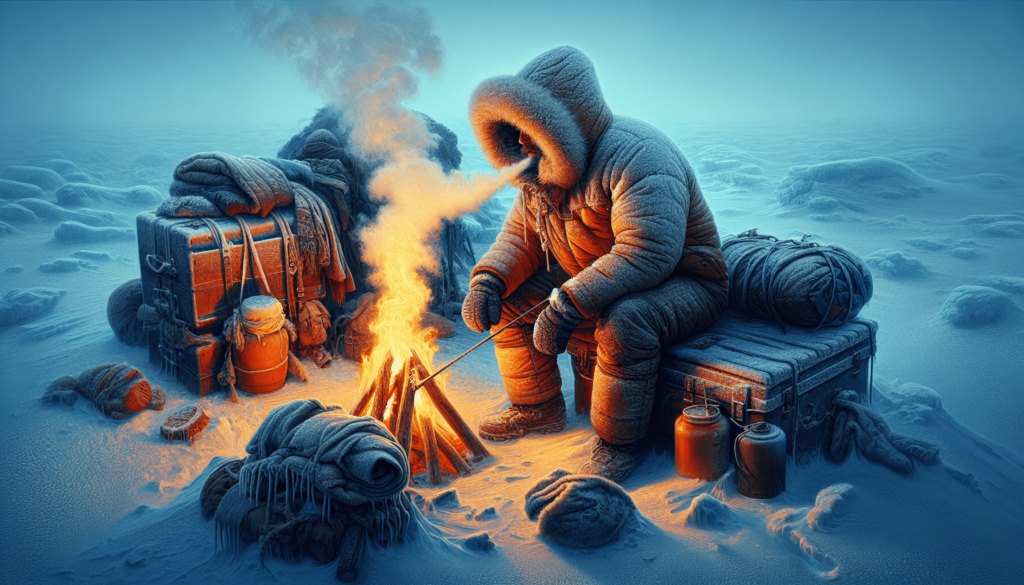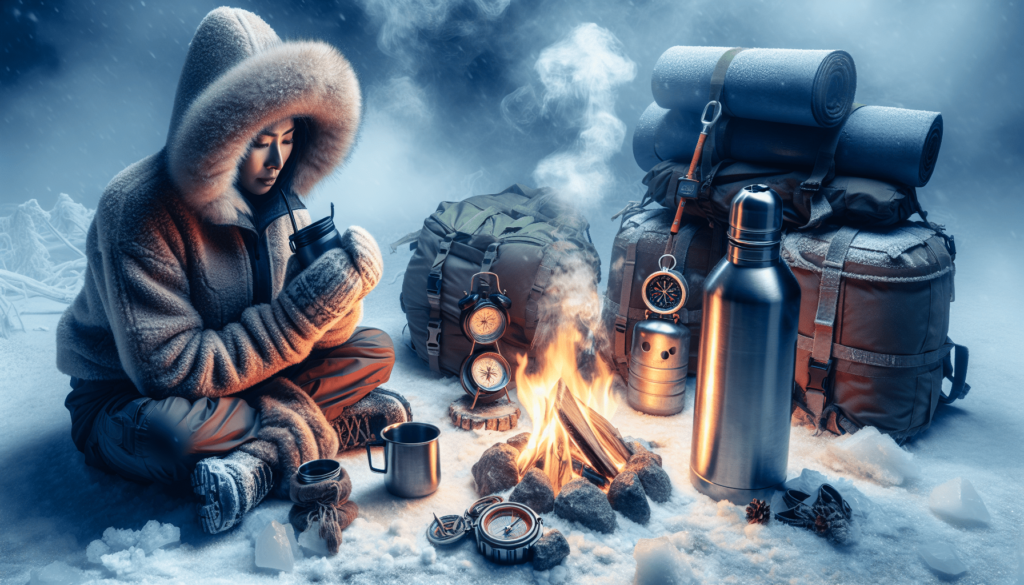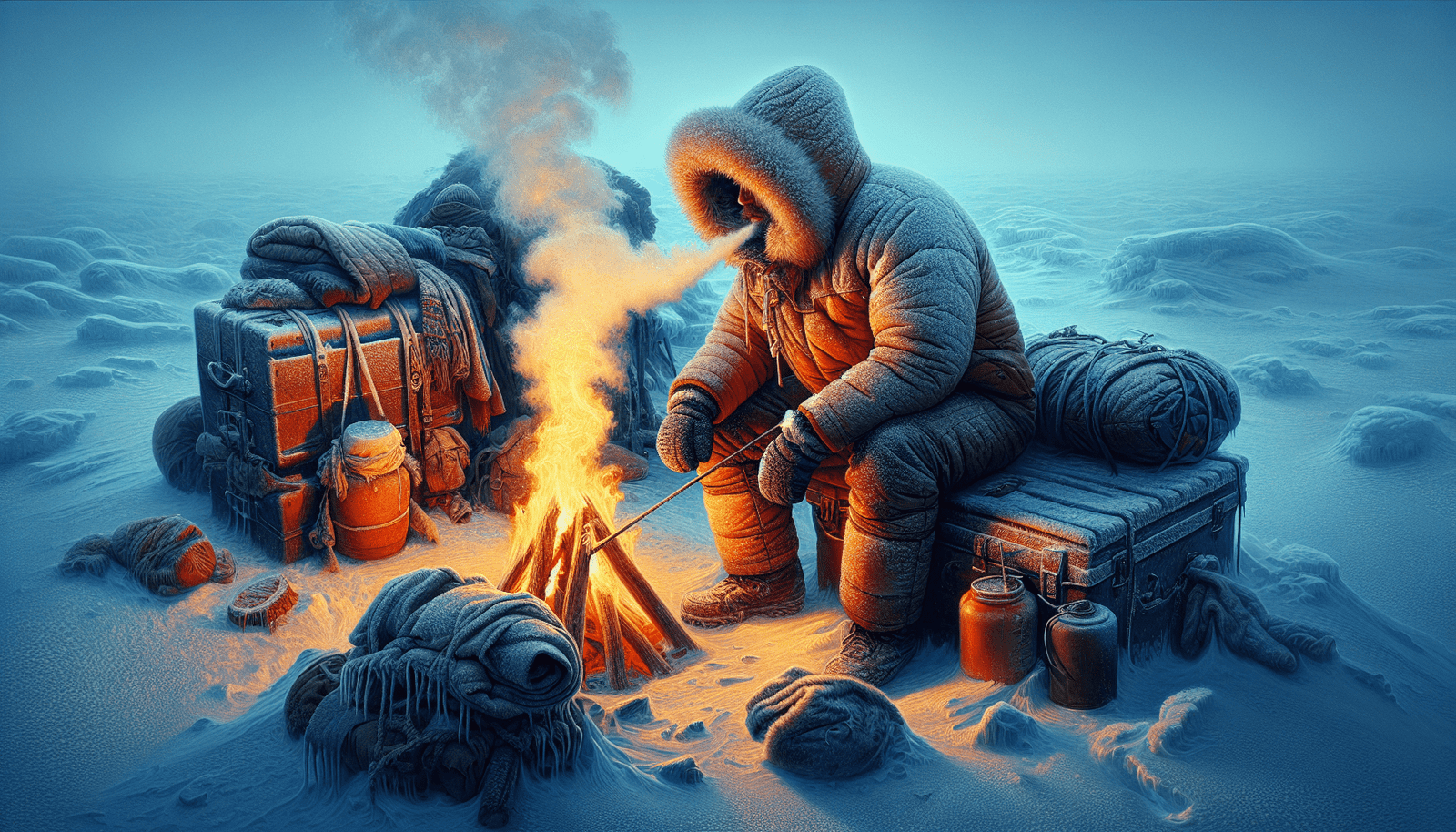Imagine embarking on an off-grid adventure, where you and your family learn to live self-sufficiently and thrive in the face of challenges. From building a survival garden to mastering emergency medical knowledge, this journey empowers you with valuable skills. You’ll discover how to navigate through the wilderness, confront potential dangers, and handle unexpected situations. This isn’t about preparing for doomsday; it’s about embracing self-reliance, connecting with nature, and gaining the confidence to thrive no matter what life throws your way. So, are you ready to embark on your own off-grid adventure?

Understanding Hypothermia
What is hypothermia?
Hypothermia is a dangerous medical condition that occurs when your body loses heat faster than it can produce it, resulting in a dangerously low body temperature. Your normal body temperature is around 98.6°F (37°C), but when it drops below 95°F (35°C), hypothermia sets in. This can be life-threatening if not treated promptly.
Causes of hypothermia
Hypothermia can occur in various situations, but it is commonly associated with exposure to cold temperatures. Prolonged exposure to cold air, cold water, or even being dressed inadequately in low temperatures can lead to hypothermia. Other risk factors include wet clothing, being in windy conditions, and not consuming enough calories to keep your body warm.
Symptoms of hypothermia
Recognizing the symptoms of hypothermia is crucial for prompt treatment. Early symptoms may include shivering, fatigue, and confusion. As hypothermia progresses, symptoms can worsen and may include loss of coordination, slurred speech, and drowsiness. In severe cases, shivering may stop, and the person may become unconscious. It’s important to seek medical attention immediately if you suspect someone is experiencing hypothermia.
Preventing Hypothermia
Dress appropriately for the weather
One of the most effective ways to prevent hypothermia is by dressing appropriately for the weather. Wear multiple layers of clothing to trap heat against your body. Start with a base layer made of moisture-wicking material, followed by insulating layers like fleece or wool, and finish with a waterproof and windproof outer layer. Don’t forget to wear a warm hat, gloves, and insulated footwear.
Layering clothing
Layering clothing is an essential technique to regulate your body temperature and prevent hypothermia. By wearing multiple layers, you can adjust your clothing to adapt to changing weather conditions. This method allows you to add or remove layers as needed to maintain a comfortable body temperature.
Keep your extremities warm
Your extremities, such as your hands and feet, are susceptible to cold temperatures and are at greater risk of developing frostbite. To keep them warm, wear thermal socks, insulated gloves or mittens, and use hand and foot warmers if necessary. Consider investing in quality waterproof and insulated boots to protect your feet from the cold and wet conditions.
Stay hydrated
Staying hydrated is important for overall health, but it is especially crucial in preventing hypothermia. Dehydration can impair your body’s ability to regulate temperature, making you more susceptible to hypothermia. Drink plenty of fluids, even if you don’t feel thirsty, and avoid alcoholic and caffeinated beverages, as they can dehydrate you.
Avoid alcohol and caffeine
Alcohol and caffeine can increase your risk of hypothermia. Both substances can cause dehydration, which impairs your body’s ability to regulate temperature. Additionally, alcohol can give you a false sense of warmth, leading you to underestimate the effects of cold weather. It’s best to avoid consuming alcohol and caffeine when you are in cold environments or at risk of hypothermia.
Building a Shelter
Choosing the right location
When building a shelter in a cold environment, choosing the right location is essential for your safety and warmth. Look for a location that offers natural protection from the elements, such as a hillside or dense vegetation. Avoid areas prone to flooding or avalanche risks. Additionally, consider the direction of the wind and position your shelter so that the entrance is facing away from the wind to minimize drafts.
Materials for shelter construction
The materials you use for shelter construction can make a significant difference in keeping you warm. Utilize natural resources such as branches, leaves, and snow to create insulation. These materials can provide a layer of warmth and help reduce heat loss. If available, use a tarp, emergency blanket, or even a space blanket as a waterproof and windproof outer layer for your shelter.
Insulating your shelter
Insulating your shelter is crucial for retaining heat and preventing hypothermia. Layering materials such as branches, leaves, and snow along the walls and roof of your shelter can provide additional insulation. This helps to trap your body heat inside and reduce heat loss. Creating a thick layer of insulation, especially against the ground, can also help prevent the cold from seeping in.
Creating a fire inside the shelter
Building a fire inside your shelter can provide additional warmth and help combat the cold. Ensure that your shelter is constructed with fire safety in mind, leaving enough ventilation to allow smoke to escape. Use rocks or other non-flammable materials to create a fire pit inside the shelter, and gather firewood that is dry and easily combustible. Remember to keep a safe distance between the fire and the shelter walls to prevent accidents.
Creating Fire in Cold Environments
Gathering firewood
When creating a fire in cold environments, it’s essential to gather an ample supply of firewood. Look for dry wood that is small in diameter, as larger pieces may be harder to ignite. Fallen branches, dead trees, or driftwood are good sources of firewood. Ensure that the wood is dry and free from moisture, as wet wood can be challenging to burn and produce less heat.
Choosing the right fire-starting methods
In cold environments, it can be challenging to start a fire using traditional methods like matches or lighters. It’s essential to have alternative fire-starting methods available. Some effective options include using a ferro rod or fire striker, waterproof matches, or a butane lighter with a windproof feature. Consider carrying multiple fire-starting tools in case one fails or gets wet.
Building a fire in adverse conditions
Building a fire in adverse conditions, such as strong winds or wet environments, requires proper techniques. Look for a sheltered spot to minimize the effects of wind on your fire. If the ground is wet, create a base layer of rocks or elevate the fire off the ground using a fire pan or other non-flammable surface. An alternative is constructing a fire platform using logs. This raises the fire off the wet ground and provides better airflow for combustion.
Maintaining and feeding the fire
Once you have successfully built a fire, it’s important to maintain and feed it to ensure a constant source of warmth. Keep a steady supply of dry firewood nearby to add to the fire as needed. Avoid adding too much wood at once, as it can smother the fire. Gradually feed the fire with smaller, manageable pieces of wood to maintain a steady and consistent heat output.

Emergency Heat Sources
Portable heaters and warmers
In emergency situations, portable heaters and warmers can be invaluable for providing heat. Battery-powered heaters or camping heaters can offer a source of warmth in enclosed spaces. Additionally, hand warmers or body warmers that can be activated by exposing them to air can provide localized heat, making them ideal for warming extremities such as hands and feet.
Hot water bottles
Hot water bottles are a simple yet effective method for generating heat. Fill a heat-resistant bottle with hot water and secure the cap tightly. Place the bottle inside your clothing or sleeping bag to keep your body warm. Hot water bottles can also be used to warm up cold hands and feet.
Chemical hand warmers
Chemical hand warmers are small packets that contain a mixture of chemicals that produce heat when exposed to air. These can be activated by shaking or squeezing the packet, and they provide several hours of heat. Chemical hand warmers are compact and portable, making them convenient to carry as emergency heat sources.
Heat reflective blankets
Heat reflective blankets, often referred to as emergency blankets or space blankets, are designed to reflect your body heat back towards you. These lightweight and compact blankets are made of a reflective material, usually Mylar, and can help prevent heat loss in cold environments. They are an essential item to include in your emergency kit or survival gear.
Food and Nutrition for Cold Weather Survival
Caloric intake requirements
Consuming enough calories is crucial for cold weather survival. Your body requires more energy to maintain its core temperature in cold environments. Increase your caloric intake by consuming high-energy foods. It’s recommended to consume an extra 500-800 calories per day when exposed to extreme cold and engaged in physical activities.
High-energy food sources
When preparing for cold weather survival, prioritize high-energy foods that provide essential nutrients. Pack nutrient-dense options such as nuts, seeds, dried fruits, and energy bars. Include complex carbohydrates like whole grains and legumes for sustained energy. Fats from sources like peanut butter and high-quality oils can also provide long-lasting energy.
Hot food and drinks
Consuming hot food and drinks is not only comforting but also helps raise your body temperature. Prioritize warm meals to provide internal heat. Instant soups, stews, and hot drinks like tea or hot chocolate can provide both hydration and warmth. Consider investing in portable camping stoves or food thermoses to heat and carry food on the go.
The importance of hydration
Staying hydrated is vital for cold weather survival. Cold air can be dehydrating, and you may not feel as thirsty in cold environments. Drink plenty of fluids, including water, herbal tea, or warm drinks, to prevent dehydration. Avoid consuming excessive amounts of caffeine or alcohol, as they can dehydrate you further.
First Aid for Hypothermia
Recognizing hypothermia symptoms
Recognizing the symptoms of hypothermia is crucial for providing immediate first aid. Look for signs such as shivering, pale or cold skin, confusion, slurred speech, and loss of coordination. If someone is exhibiting these symptoms, take immediate action to prevent further heat loss and seek emergency medical assistance.
Gentle rewarming techniques
If someone is experiencing hypothermia, gentle rewarming techniques can be applied to raise their body temperature. Remove wet clothing and replace it with dry, warm clothing. Cover the person with blankets or a sleeping bag for additional insulation. Provide warm liquids if the person is conscious and able to swallow. Avoid using direct heat sources like heating pads or hot water baths, as they can cause burns.
CPR considerations
In severe cases of hypothermia, the person may lose consciousness and experience cardiac arrest. CPR (Cardiopulmonary Resuscitation) may be necessary in these situations. If you are trained in CPR, follow the proper techniques for providing chest compressions and rescue breaths. It’s important to note that in hypothermic conditions, CPR should be continued for a longer duration before considering cessation.
Emergency medical assistance
Hypothermia is a medical emergency, and it’s important to seek professional medical assistance as soon as possible. Call emergency services or transport the person to the nearest medical facility for proper evaluation and treatment. Timely medical intervention can greatly improve the chances of survival and recovery.
Emergency Signaling Techniques
Using mirrors or reflective surfaces
Mirrors or other reflective surfaces are effective tools for signaling for help in emergency situations. Use the reflection to direct the sunlight towards a potential rescuer. Aim the reflection in the direction of aircraft or other search parties. If you don’t have a mirror, other shiny objects like CDs, metal pots, or even a smartphone screen can be used as makeshift signaling devices.
Building signal fires
Signal fires are an effective way to attract attention and signal for help. Build a large fire using dry and easily combustible materials. Look for a location with maximum visibility, such as an open area or the top of a hill. Create thick smoke by adding green vegetation or damp materials to the fire. Three quick bursts of smoke or fire can serve as an internationally recognized distress signal.
Whistle signaling
A whistle is a compact and efficient tool for emergency signaling. Sound carries farther than the human voice, making a whistle an effective means of attracting attention. Use three short blasts or other distinct patterns to signal for help. Carry a whistle with you at all times in your outdoor adventure gear or survival kit.
Creating visible distress signals
In addition to auditory signals, visible distress signals can greatly increase your chances of being located during an emergency. Use brightly colored clothing or items to attract attention. Hang or wave a brightly colored object such as a flag, bandana, or emergency blanket. Make sure the signal is contrasted against the natural surroundings to enhance its visibility.
Proper Winter Gear and Equipment
Insulated clothing
Investing in insulated clothing is crucial for staying warm in cold environments. Look for jackets, pants, and base layers that provide insulation without sacrificing breathability. Insulated clothing traps body heat while allowing moisture to escape, keeping you dry and comfortable. Choose materials like synthetic fibers, down, or wool for optimal insulation.
Waterproof boots
Waterproof boots are essential for protecting your feet from cold, wet conditions. Look for boots made with waterproof materials like Gore-Tex or neoprene. Insulation within the boots will help keep your feet warm. Ensure a proper fit and consider wearing moisture-wicking socks to further enhance comfort and warmth.
Cold weather sleeping bags
A cold weather sleeping bag is a vital piece of equipment for staying warm during overnight outdoor adventures. Look for sleeping bags specifically designed for cold temperatures, with temperature ratings that suit the conditions you expect to encounter. Consider features like draft collars and hoods to minimize heat loss during sleep.
Hand and foot warmers
Hand and foot warmers are compact and portable heat sources that can provide instant warmth to your extremities. These disposable warmers are activated by exposing them to air, and they typically provide several hours of heat. Slip them into your gloves, socks, or boots to keep your hands and feet warm during cold weather activities.
Planning and Preparedness
Creating a winter survival kit
Having a well-stocked winter survival kit is essential for your safety and peace of mind. Include items such as emergency blankets, hand warmers, extra clothing, high-energy food, water, a compact stove, matches, and a first aid kit. Customize your kit based on the activities you’ll be undertaking and the potential risks you may encounter.
Emergency communication devices
Emergency communication devices are crucial for staying connected during emergencies. Carry a fully charged cell phone, but be aware that reception may be limited in remote areas. Consider investing in a satellite phone or a personal locator beacon (PLB) for reliable communication in areas with no cell signal. Inform others about your communication plan and how to respond in case of emergency.
Knowing evacuation routes
In cold weather environments, it’s important to be familiar with evacuation routes and emergency shelters. Research and plan your escape routes in advance, including alternative routes in case of road closures. Pay attention to weather forecasts and any advisories or warnings issued by local authorities. Stay informed about emergency shelters or community centers that may provide refuge during extreme weather conditions.
Informing others about your plans
Before embarking on any outdoor adventure in cold weather, it’s crucial to inform someone about your plans. Share details about your intended route, expected return time, and emergency contact information with a reliable person. This ensures that someone is aware of your whereabouts and can initiate a search and rescue operation if necessary.
In conclusion, understanding hypothermia and knowing how to prevent it is crucial for your safety and survival in cold weather. By dressing appropriately, building a shelter, creating fire, utilizing emergency heat sources, consuming the right food and nutrition, and knowing important first aid and emergency signaling techniques, you can enhance your preparedness and increase your chances of staying warm and surviving the cold. Additionally, having proper winter gear and equipment, planning and preparedness, and informing others about your plans are essential steps towards ensuring a safe and enjoyable experience in cold weather conditions. Embrace self-reliance, connect with nature, and empower yourself with valuable skills to thrive in any situation. Stay warm and survive the cold!

